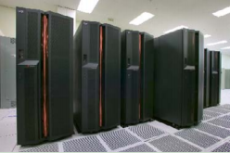New IBM Cluster to Go into Production in January
December 1, 2005
NERSC users who run jobs on 256 to 512 processors will benefit from the “Bassi,” the new IBM cluster which goes into production on Monday, Jan. 9, 2006. During the acceptance testing, users reported that codes ran up to 10 times faster on Bassi than on Seaborg.
The new machine is an IBM p575 POWER 5 system with 888 processors available for parallel scientific computation. Each Bassi processor has a theoretical peak performance of 7.6 Gflop/s. The processors are distributed among 111 compute nodes with eight processors per node. Processors on each node have a shared memory pool of 32 Gbytes.
A Bassi node is an example of a shared memory processor, or SMP.
The compute nodes are connected to each other with a high-bandwidth, low-latency switching network. Each node runs its own full instance of the standard AIX operating system. The disk storage system is a distributed, parallel I/O system called GPFS. Additional nodes serve exclusively as GPFS servers. Bassi's network switch is the IBM "Federation" HPS switch which is connected to a two-link network adapter on each node.
Scientifically productive
One of the early users during the acceptance testing was the combustion simulation team led by Jackie Chen of Sandia National Laboratories. Chen’s group had been awarded 2 million hours on Seaborg under DOE’s INCITE program, and were able to run their three-dimensional direct numerical simulation of turbulent nonpremixed combustion code for an additional one millions hours on Bassi.
“We had a major success enabled by Bassi — the successful completion of our INCITE project to perform direct numerical simulation of a turbulent nonpremixed CO/H2 jet flame with detailed chemistry,” recounted Evatt Hawkes, a member of Chen’s group.
“Our project required a very long stretch of using a large fraction of Bassi processors — 512 processors for essentially an entire month. During this period we experienced only a few minor problems, which is exceptional for a pre-production machine and enabled us to complete our project against a tight deadline. We were very impressed with the reliability of the machine.”
Hawkes noted that their code also ported quickly to Bassi, starting with a code already ported to Seaborg’s architecture.
“Bassi performs very well for our code — with Bassi's faster processors we were able to run on far fewer processors (512 as opposed to 4096), and still complete the simulations more rapidly,” Hawkes wrote. “Based on scalar tests, it is approximately seven times faster than Seaborg, and one-and-a-half times faster than a 2.0 GHz Opteron processor. Also, the parallel efficiency is very good. In a weak scaling test we obtain approximately 78 percent parallel efficiency using 768 processors, compared with about 70 percent on Seaborg.”
System Named in Honor of Italian Physicist
The machine is named in honor of Laura Bassi, a noted Newtonian physicist of the eighteenth century. Born on Oct. 31, 1711, in Bologna, she was educated privately, Bassi studied logic, metaphysics, philosophy, chemistry, hydraulics, mathematics, mechanics, algebra, geometry, and ancient and modern languages (Greek, Latin, French, and Italian).
Bassi was appointed professor of anatomy at the University of Bologna in 1731, and has been cited as the first woman to officially teach at a European university. She was elected to the Academy of the Institute for Sciences in 1732, and was given the Chair of Philosophy at the University of Bologna in 1733. In 1738, she married her colleague Dr. Giuseppe Veratti. They had 12 children.
While raising her family, she successfully petitioned for wider responsibilities and a higher salary to cover the cost of equipment for physical and electrical experiments. She continued her life-long interest in physics, lecturing from her home while her children were small then returning to the university at age 65 as a professor of experimental physics in 1776. She died on Feb. 20, 1778, at age 66.
About NERSC and Berkeley Lab
The National Energy Research Scientific Computing Center (NERSC) is a U.S. Department of Energy Office of Science User Facility that serves as the primary high performance computing center for scientific research sponsored by the Office of Science. Located at Lawrence Berkeley National Laboratory, NERSC serves almost 10,000 scientists at national laboratories and universities researching a wide range of problems in climate, fusion energy, materials science, physics, chemistry, computational biology, and other disciplines. Berkeley Lab is a DOE national laboratory located in Berkeley, California. It conducts unclassified scientific research and is managed by the University of California for the U.S. Department of Energy. »Learn more about computing sciences at Berkeley Lab.








